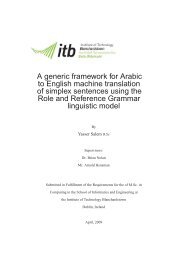On the occurrence and consequences of inaccurate ... - Acsu Buffalo
On the occurrence and consequences of inaccurate ... - Acsu Buffalo
On the occurrence and consequences of inaccurate ... - Acsu Buffalo
You also want an ePaper? Increase the reach of your titles
YUMPU automatically turns print PDFs into web optimized ePapers that Google loves.
Although <strong>the</strong> results are not statistically signi"cant due to a limited sample size,<br />
I "nd that replacing <strong>the</strong> Lee <strong>and</strong> Ready classi"cation with <strong>the</strong> true classi"cation<br />
eliminates three <strong>of</strong> <strong>the</strong> "ve periods <strong>of</strong> abnormal buying activity for small trades<br />
surrounding bad announcements. While <strong>the</strong> evidence is not strong enough to<br />
conclude that Lee's result is driven entirely by <strong>inaccurate</strong> trade classi"cation, it<br />
is certainly su$cient to document <strong>the</strong> impact <strong>of</strong> <strong>inaccurate</strong> trade classi"cation<br />
on research.<br />
4.3. Components <strong>of</strong> <strong>the</strong> bid}ask spread<br />
As discussed in <strong>the</strong> introduction, <strong>the</strong> Lee <strong>and</strong> Ready algorithm is likely to<br />
overestimate <strong>the</strong> costs associated with trading. This stems from <strong>the</strong> fact that <strong>the</strong><br />
algorithm classi"es trades that occur above (below) <strong>the</strong> spread midpoint as buys<br />
(sells). If a seller-initiated transaction occurs above <strong>the</strong> midpoint, it will be<br />
misclassi"ed as buyer-initiated by <strong>the</strong> algorithm <strong>and</strong> price improvement will be<br />
underestimated (i.e. transaction costs will be overestimated).<br />
I test <strong>the</strong> hypo<strong>the</strong>sis that <strong>the</strong> use <strong>of</strong> Lee <strong>and</strong> Ready algorithm results in <strong>the</strong><br />
overestimation <strong>of</strong> transaction costs by estimating a two-component model <strong>of</strong><br />
<strong>the</strong> bid}ask spread (see Glosten <strong>and</strong> Harris, 1988) using both <strong>the</strong> Lee <strong>and</strong> Ready<br />
<strong>and</strong> <strong>the</strong> true classi"cations. The complete results are presented in Appendix B.<br />
I "nd that <strong>the</strong> use <strong>of</strong> <strong>the</strong> Lee <strong>and</strong> Ready method leads to a statistically signi"cant<br />
one-cent overestimation <strong>of</strong> <strong>the</strong> order processing component <strong>of</strong> <strong>the</strong> spread on<br />
average. The adverse selection component is roughly <strong>the</strong> same using ei<strong>the</strong>r<br />
classi"cation. This implies that actual transaction costs are lower than those<br />
suggested by studies that utilize <strong>the</strong> algorithm. While $0.01 is small in an<br />
absolute sense, it represents a signi"cant di!erence in trading costs, particularly<br />
for large transactions.<br />
5. Conclusion<br />
E.R. Odders-White / Journal <strong>of</strong> Financial Markets 3 (2000) 259}286 279<br />
The goal <strong>of</strong> this study is to examine <strong>the</strong> performance <strong>of</strong> trade classi"cation<br />
algorithms <strong>and</strong> to determine <strong>the</strong> degree to which misclassi"cation biases <strong>the</strong><br />
results <strong>of</strong> economic research. I "nd that <strong>the</strong> trade classi"cation algorithm<br />
recommended by Lee <strong>and</strong> Ready performs quite well in general, correctly<br />
classifying 85% <strong>of</strong> <strong>the</strong> transactions in my sample. The algorithm systematically<br />
misclassi"es certain types <strong>of</strong> transactions, however. In particular, transactions<br />
inside <strong>the</strong> bid}ask spread, small transactions, <strong>and</strong> transactions in large or<br />
frequently traded stocks are <strong>of</strong>ten misclassi"ed.<br />
Ano<strong>the</strong>r partial explanation may be <strong>the</strong> sub-optimal individual investor behavior recently<br />
documented by Barber <strong>and</strong> Odean (2000), among o<strong>the</strong>rs.
















